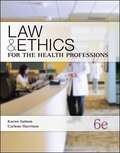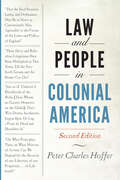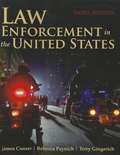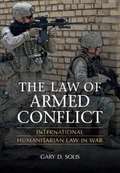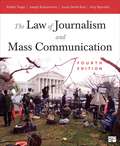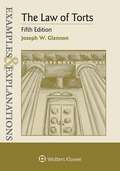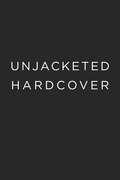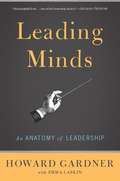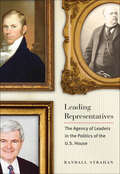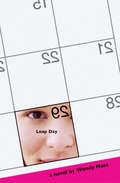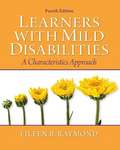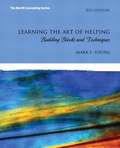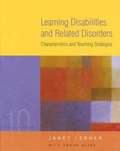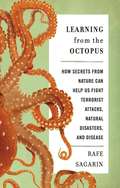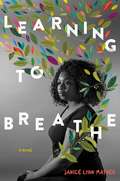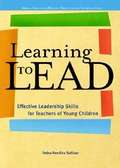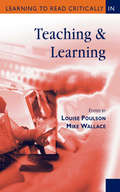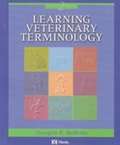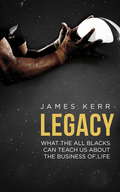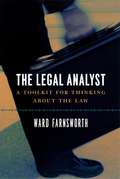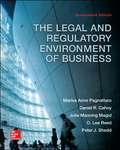- Table View
- List View
Law and Ethics for the Health Professions (6th Edition)
by Karen Judson Carlene HarrisonLaw & Ethics for the Health Professions, sixth edition, provides an overview of the laws and ethics you should know to help you give competent, compassionate care to patients that is also within acceptable legal and ethical boundaries. The text can also serve as a guide to help you resolve the many legal and ethical questions you may reasonably expect to face as a student and, later, as a health care practitioner.
Law and People in Colonial America
by Peter Charles HofferAn essential, rigorous, and lively introduction to the beginnings of American law.How did American colonists transform British law into their own? What were the colonies' first legal institutions, and who served in them? And why did the early Americans develop a passion for litigation that continues to this day? In Law and People in Colonial America, Peter Charles Hoffer tells the story of early American law from its beginnings on the British mainland to its maturation during the crisis of the American Revolution. For the men and women of colonial America, Hoffer explains, law was a pervasive influence in everyday life. Because it was their law, the colonists continually adapted it to fit changing circumstances. They also developed a sense of legalism that influenced virtually all social, economic, and political relationships. This sense of intimacy with the law, Hoffer argues, assumed a transforming power in times of crisis. In the midst of a war for independence, American revolutionaries used their intimacy with the law to explain how their rebellion could be lawful, while legislators wrote republican constitutions that would endure for centuries.Today the role of law in American life is more pervasive than ever. And because our system of law involves a continuing dialogue between past and present, interpreting the meaning of precedent and of past legislation, the study of legal history is a vital part of every citizen's basic education. Taking advantage of rich new scholarship that goes beyond traditional approaches to view slavery as a fundamental cultural and social institution as well as an economic one, this second edition includes an extensive, entirely new chapter on colonial and revolutionary-era slave law. Law and People in Colonial America is a lively introduction to early American law. It makes for essential reading.
Law Enforcement in the United States
by James A. Conser Rebecca Paynich Terry E. GingerichThis book is an ideal introduction to law enforcement and goes beyond discussions of local policing to examine how forces like technology, privatization, and the threat of terrorism are affecting law enforcement on local, state, and national levels. Readers will learn how these diverse and unpredictable forces are shaping the future of law enforcement in the United States, and will come away with the ability to think critically about law enforcement issues. New Material added to the revised and updated Third Edition:-"Stay Current" boxes throughout the text offer references and key search terms for further internet research-Updated figures, tables, charts and other statistical and descriptive information-A New chapter on socialization, advancement, and professionalism, including ethics and misconduct-A New chapter with emphasis on law enforcement's role in national security, homeland security, and protecting private assets-A separate chapter on "Policing Strategies, Tactics, and Daily Operations"-An expanded and updated chapter on management issues-Updated and expanded appendices
The Law of Armed Conflict: International Humanitarian Law in War
by Gary D. SolisThe Law of Armed Conflict: International Humanitarian Law in War introduces law students and undergraduates to the law of war in an age of terrorism. What law of armed conflict/international humanitarian law applies to particular armed conflicts? Does that law apply to terrorists as well? What is the status of participants in an armed conflict? What constitutes a war crime? What is a lawful target and how are targeting decisions made? What are rules of engagement? What weapons are lawful and unlawful, and why? This text takes the reader through these essential questions of the law of armed conflict and international humanitarian law to an awareness of finer points of battlefield law. The U. S. -weighted text incorporates lessons from many nations and includes hundreds of cases from jurisdictions worldwide.
The Law of Journalism and Mass Communication (Fourth Edition)
by Joseph Russomanno Susan Dente Ross Amy L. Reynolds Robert TragerWith its clear and engaging writing, essential coverage and analysis, and substantive discussion of case law, this is a popular and comprehensive introduction to the law of journalism and mass communication. It includes: Photos and feature boxes, as well as a marginal glossary of legal terms and concepts Hypothetical cases which start each chapter and are then followed by a timeline showing landmark cases in context. Real World Law boxes illustrating contemporary examples and emerging topics Points of Law boxes underlining key points and legal tests. A student companion website to help aid review and study.
The Law of Torts: Examples and Explanations
by Joseph W. GlannonA favorite among successful students, and often recommended by professors, the unique Examples & Explanations series gives you extremely clear introductions to concepts followed by realistic examples that mirror those presented in the classroom throughout the semester. Use at the beginning and midway through the semester to deepen your understanding through clear explanations, corresponding hypothetical fact patterns, and analysis. Then use to study for finals by reviewing the hypotheticals as well as the structure and reasoning behind the accompanying analysis. Designed to complement your casebook, the trusted Examples & Explanations titles get right to the point in a conversational, often humorous style that helps you learn the material each step of the way and prepare for the exam at the end of the course. The unique, time-tested Examples & Explanations series is invaluable to teach yourself the subject from the first day of class until your last review before the final. Each guide: helps you learn new material by working through chapters that explain each topic in simple language challenges your understanding with hypotheticals similar to those presented in class provides valuable opportunity to study for the final by reviewing the hypotheticals as well as the structure and reasoning behind the corresponding analysis quickly gets to the point in conversational style laced with humor remains a favorite among law school students is often recommended by professors who encourage the use of study guides works with ALL the major casebooks, suits any class on a given topic provides an alternative perspective to help you understand your casebook and in-class lectures
Laws, Theories, and Patterns in Ecology
by Walter K. DoddsIntroductory material describes how the practice of science in general, and ecology specifically, yields theories and laws. Dodds also discusses why such ideas are only useful if they have predictive ability, and delineates the scope of these generalizations and the constraints that limit their application.
Leadership in Leisure Services: Making a Difference (Third Edition)
by Debra J. JordanLeadership is a process and an experience that impacts all of us in our roles as leaders and as followers. This text presents leadership as a personal journey that takes conscious effort to undertake and develop. Leadership is one of the keystones of successful parks, recreation and leisure services agencies, organizations and programs. How we deal with people,how we interact with fellow staff supervisors, participants, and the general public all make an incredible statement about who we are and what our profession is about. This book is designed to help students of leadership begin, or renew, their personal journey toward leadership.
Leading Minds: An Anatomy Of Leadership
by Howard Gardner Emma LaskinPsychologist Howard Gardner, creator of the multiple intelligences framework and author of many books on the mind, explores the major facets of leadership from the perspective of psychology. In this work for general readers (first published in 1995), he presents a framework for understanding leadership and illustrates the framework with profiles of famous leaders such as anthropologist Margaret Mead, civil rights leader Martin Luther King, Jr. , Pope John XXIII, and Mahatma Gandhi. The book is illustrated with b&w historical photos of leaders. This edition contains a new preface by Gardner reviewing his reasons for writing the book, offering reflections on the past 15 years in leadership studies, and commenting on how leadership has changed in the era of "truthiness, twaddle, and Twitter. " Annotation ©2012 Book News, Inc. , Portland, OR (booknews. com)
Leading Representatives: The Agency of Leaders in the Politics of the U.S. House (Interpreting American Politics)
by Randall StrahanMany studies of Congress hold that congressional leaders are "agents" of their followers, ascertaining what legislators agree on and acting to advance those issues rather than stepping to the forefront to shape national policy or the institution they lead. Randall Strahan has long argued that this approach to understanding leadership is incomplete. Here he demonstrates why and explores the independent contributions leaders make in congressional politics.Leading Representatives is a study that draws on both historical and contemporary cases to show how leaders in the U.S. House have advanced changes inside Congress and in national policy. Exploring the tactics, tenure, and efficacy of the leadership of three of the most colorful and prominent Speakers of the House—Henry Clay, Thomas Reed, and Newt Gingrich—Strahan finds that these men, though separated in time and of differing thought and actions, were all leaders willing to take political risks to advance goals they cared about deeply. As a result, each acted independently of his followers to alter the political landscape. Strahan makes use of a wide range of resources, including the former representatives' papers and correspondence and interviews with Gingrich and his staffers, to demonstrate how these important leaders influenced policy and politics and where they ran aground.In expounding lessons Strahan has gleaned over two decades of studying U.S. legislative politics, Leading Representatives offers a new theoretical framework—the conditional agency perspective—that effectively links contextual perspectives as applied to congressional leadership with those emphasizing characteristics of individual leaders. This engagingly written book will be of interest to political scholars of all stripes as well as readers inclined to learn more about the history and inner workings of the House.
Leap Day (Little Brown Novels)
by Wendy MassSometimes Josie wonders what other people are thinking, and in this uniquely constructed novel, readers "leap" into the minds and viewpoints of Josie and everyone around her as she goes through her day. Josie learns that birthday surprises, play auditions, and the all-important initiation at the lake may be the things that define her today, but what defines her tomorrow and in the days to come are the people that touch her life at every moment. This fascinating and surprising novel, now in paperback, is full of everyday imaginations and truths in the life and future of one everygirl teenager.
Learners with Mild Disabilities: A Characteristics Approach (4th Edition)
by Eileen B. RaymondA critical look at four high-prevalence mild disabilities as seen from several unique perspectives: mild intellectual disabilities, learning disabilities, emotional/behavioral disorders, and ADHD. The text also considers the Autism Spectrum Disorders, such as HFA and Asperger's Syndrome, in addition to other mild conditions such as communication disorders. This text looks first at the concept of disability from conventional categorical perspectives, and then shifts to focusing on learners from the perspective of alternative, non-categorical frameworks. It describes students with disabilities and related conditions with respect to a variety of individual strengths and needs, considering their cognitive, perceptual, language, academic learning, and social/emotional characteristics. The reader is encouraged to apply these conceptual frameworks through the analysis of numerous vignettes and extended case studies that are drawn from the experiences of real children and teachers throughout the text. Using this non-categorical framework best prepares special educators for the complex job of providing effective services to the full and unique spectrum of students with mild disabilities.
Learning, 5th Edition
by A. Charles CataniaThe 5th Edition surveys the major areas in the psychology of learning from a consistent behavioral point of view. Learning explores the continuities between human learning and the learning of other animals. The book organizes the phenomena of learning in a systematic way, moving from Behavior Without Learning (evolution) to Learning Without Words (basics in nonhuman behavior and learning) to Learning With Words (human learning and memory).
Learning and Memory: From Brain to Behavior (Second Edition)
by Mark A. Gluck Eduardo Mercado Catherine E. MyersDevelopments in neuroscience have changed the field of learning and memory significantly in the last ten years. This comprehensive introduction to learning and memory covers behavioural processes, brain systems, and clinical perspectives.
Learning The Art of Helping: Building Blocks and Techniques (5th Edition)
by Mark E. YoungThis best-selling resource is a great refresher and hands-on resource for counselors new to their professions. It's packed with step-by-step guidance for developing the skills and techniques they need to effectively help their clients. It covers not just the basic building blocks in the profession, but also what the author calls the "megaskills" and common curative factors that lie behind the methods. The tone is conversational and the references are very useful.
Learning Disabilities and Related Disorders: Characteristics and Teaching Strategies
by Janet W. Lerner Frank KlineDesigned to help pre-service teachers and practicing professionals evaluate and aid students with disabilities, this comprehensive text is guided by three main principles: to aid in the assessment and evaluation of students with learning disabilities, to demonstrate Learning Disabled (LD) theory and its practical applications through the use of case studies, and to provide the most up-to-date information on recent developments and topics of debate in the field. The Tenth Edition continues to stress familiarity with state and national standards, specifically those from the Council for Exceptional Children (CEC).
Learning From the Octopus: How Secrets from Nature Can Help Us Fight Terrorist Attacks, Natural Disasters, and Disease
by Rafe SagarinDespite the billions of dollars we've poured into foreign wars, homeland security, and disaster response, we are fundamentally no better prepared for the next terrorist attack or unprecedented flood than we were in 2001. Our response to catastrophe remains unchanged: add another step to airport security, another meter to the levee wall. This approach has proved totally ineffective: reacting to past threats and trying to predict future risks will only waste resources in our increasingly unpredictable world. In Learning from the Octopus, ecologist and security expert Rafe Sagarin rethinks the seemingly intractable problem of security by drawing inspiration from a surprising source: nature. Biological organisms have been living--and thriving--on a risk-filled planet for billions of years. Remarkably, they have done it without planning, predicting, or trying to perfect their responses to complex threats. Rather, they simply adapt to solve the challenges they continually face. Military leaders, public health officials, and business professionals would all like to be more adaptable, but few have figured out how. Sagarinargues that we can learn from observing how nature is organized, how organisms learn, how they create partnerships, and how life continually diversifies on this unpredictable planet. As soon as we dip our toes into a cold Pacific tidepool and watch what we thought was a rock turn into an octopus, jetting away in a cloud of ink, we can begin to see the how human adaptability can mimic natural adaptation. The same mechanisms that enabled the octopus's escape also allow our immune system to ward off new infectious diseases, helped soldiers in Iraq to recognize the threat of IEDs, and aided Google in developing faster ways to detect flu outbreaks. While we will never be able to predict the next earthquake, terrorist attack, or market fluctuation, nature can guide us in developing security systems that are not purely reactive but proactive, holistic, and adaptable. From the tidepools of Monterey to the mountains of Kazakhstan, Sagarin takes us on an eye-opening tour of the security challenges we face, and shows us how we might learn to respond more effectively to the unknown threats lurking in our future.
Learning to Breathe: A Novel
by Janice Lynn MatherA 2019 YALSA Best Fiction for Young Adults Selection Amelia Bloomer List&’s 2019 Top Ten Recommended Feminist Books for Young Readers A Governor General&’s Literary Award Finalist A Junior Library Guild Selection A Sheila A. Egoff Children&’s Literature Prize Semifinalist A BC Book Prize Finalist &“A love letter to girls—bittersweet and full of hope.&” —Ibi Zoboi, author of National Book Award Finalist American Street &“This is a stellar debut.&” —Brandy Colbert, award-winning author of Little & Lion and Pointe &“A vibrant, essential story of healing, resilience, and finding one&’s family.&” —Stephanie Kuehn, author of William C. Morris Award winning Charm & Strange &“A raw, beautiful, unforgettable must-read.&” —Tiffany D. Jackson, author of Allegedly &“Poetic.&” —Angela Johnson, award-winning author of Heaven &“A powerful, poignant story about refusing to let the past dictate who you are or who you will become.&” —Kirkus Reviews &“This is a well-written, thought-provoking book that tackles difficult topics…a stirring debut.&” —School Library Journal (starred review) Sixteen-year-old Indy struggles to conceal her pregnancy while searching for a place to belong in this stunning debut novel that&’s perfect for fans of Amber Smith and Sara Zarr.Indira Ferguson has done her best to live by her Grammy&’s rules—study hard in school, be respectful, and never let a boy take advantage of her. But it hasn&’t always been easy, especially living in her mother&’s shadow. When Indy is sent to stay in Nassau, trouble follows her and she must hide an unwanted pregnancy from her aunt, who would rather throw Indy out onto the street than see the truth. Completely broke with only a hand-me-down pregnancy book as a resource, Indy desperately looks for a safe space to call home. After stumbling upon a yoga retreat, she wonders if she&’s found that place. But Indy is about to discover that home is much bigger than just four walls and a roof—it&’s about the people she chooses to share it with.
Learning to Lead: Effective Leadership Skills for Teachers of Young Children
by Debra Ren-Etta SullivanDiscover the natural leader inside of you! Everyone who works with children is a teacher and a leader. An in-depth look at how leadership skills impact all areas of early childhood care and education, Learning to Lead combines accessible leadership theory and practice with important topics and issues such as human development, diversity, anti-bias, work with families, and social change. Each chapter is built around a combination of theories, examples, and reflection questions - all designed to prompt self-evaluation and personal leadership development. Learning to Lead is a must-have resource for early childhood teachers at all levels.
Learning to Read Critically in Teaching and Learning (Learning to Read Critically series)
by Mike Wallace Louise Poulson`Learning to Read Critically in Teaching and Learning offers a contribution to the debates on curriculum and pedagogy. The title itself is especially noteworthy since it indicates quite clearly that the reader is being encouraged both to learn and to develop their critical faculties on the topic of teaching and learning. This is a clever multi-layering of meaning that reflects the aims of the book extremely well' - School Leadership & Management This book combines a teaching text with exemplary reports of research and a literature review by international scholars. Part One offers ideas on: how to become a critical reader and self-critical writer of literature; how to apply these insights in planning a written assignment, dissertation or thesis. The student is provided with a framework for the critical analysis of any text and shown how to incorporate it in a literature review. Part Two presents accounts of leading-edge research from well-known contributors, offering insights into key issues in the field of teaching and learning. These accounts reflect diverse theoretical approaches, national contexts, topics, research designs, methods of data collection and analysis, and styles of reporting. The student is invited to practice literature review skills by applying the critical analysis questions to any research report. Part Three is a critical literature review of a substantive issue in teaching and learning. It shows how a high-quality literature review may be constructed and addresses key issues in the field. This book is essential for students on research-based masters and doctorate courses in teaching and learning; and for students undertaking research training in the humanities and social sciences. This series, edited by Mike Wallace, supports research-based teaching on masters and taught doctorate courses in the humanities and social sciences fields of enquiry. Each book is a 'three in one' text designed to assist advanced course tutors and dissertation supervisors with key research-based teaching tasks and aims to: * develop students' critical understanding of research literature * increase students' appreciation of what can be achieved in small-scale investigations similar to those which they undertake for their dissertation * present students with major findings, generalisations and concepts connected to their particular field.
Learning Veterinary Terminology (Second Edition)
by Douglas F. McbrideThis text is newly updated to reflect the latest terminology and features numerous new and revised pedagogical features that make it an excellent resource both in the classroom and for self-study. Brand-new additions include several new appendices, new anatomical drawings, and a more extensive index. Many sections have been completely rewritten for consistency and greater reader comprehension, and review sections now include more thought-provoking questions and multiple-choice tests.
Legacy: What The All Blacks Can Teach Us About The Business Of Life (Contemporary Security Studies)
by James KerrChampions do extra. They sweep the sheds. They follow the spearhead. They keep a blue head. They are good ancestors. In Legacy, best-selling author James Kerr goes deep into the heart of the world's most successful sporting team, the legendary All Blacks of New Zealand, to reveal 15 powerful and practical lessons for leadership and business. Legacy is a unique, inspiring handbook for leaders in all fields, and asks: What are the secrets of success - sustained success? How do you achieve world-class standards, day after day, week after week, year after year? How do you handle pressure? How do you train to win at the highest level? What do you leave behind you after you're gone? What will be your legacy?
The Legal Analyst: A Toolkit for Thinking about the Law
by Ward FarnsworthDrawing on economics, game theory, psychology, jurisprudence, and other fields. Ward Farnsworth's "The Legal Analyst" is a fascinating guide to tools for thinking about the law. Every idea is taught step-by-step, explained in clear, lively language, and illustrated with telling examples. The result is an indispensable book for law students, lawyers, scholars, and anyone else interested in legal questions.
The Legal and Ethical Environment of Business
by Terence Lau Lisa JohnsonTerence Lau & Lisa Johnson's The Legal and Ethical Environment of Business is a book for today's student, who expects learning to be comprised not only of substance, but also of interactive exercises and multimedia. This book streamlines the presentation of material to ensure that every page is relevant, engaging, and interesting to undergraduate business students, without losing the depth of coverage that they need to be successful in their academic journeys and in their professional careers. This is not Legal Environment of Business (LEB) "light." Rather, this is LEB without risk of students' eyes glazing over in boredom or from lack of comprehension. This is LEB presented in an exciting way, where every page is interesting to students and relevant to real life.
The Legal and Regulatory Environment of Business (Seventeenth Edition)
by Marisa Anne Pagnattaro Daniel R. Cahoy Julie Manning Magid O. Lee Reed Peter J. SheddUsing court cases and examples in Sidebars that are relevant for business, we underscore how learning about the law is essential to understand how the law can be used for strategic advantage and how to develop sustainable business practices.
